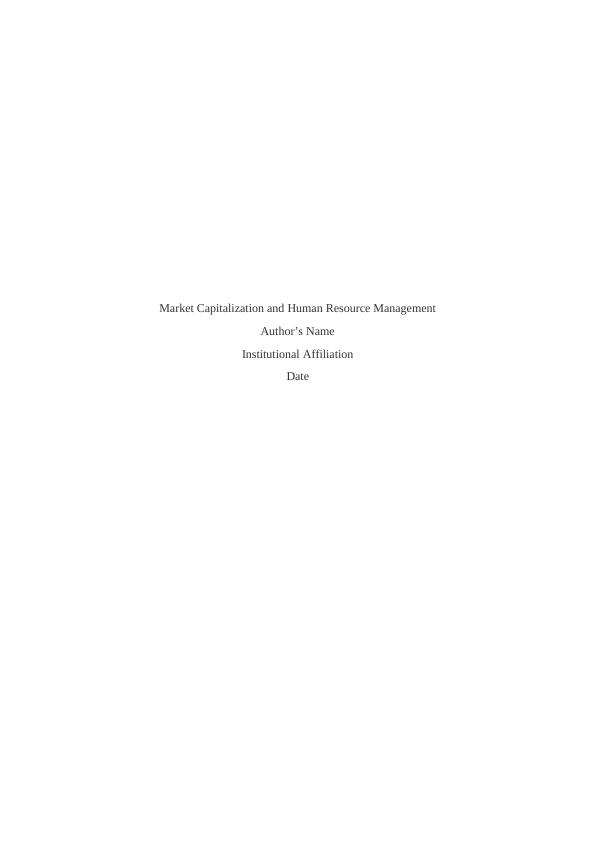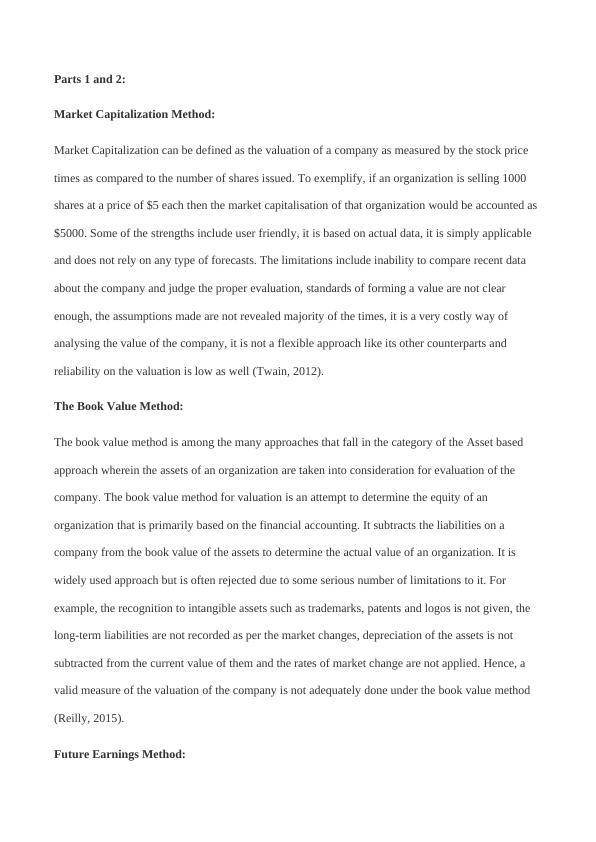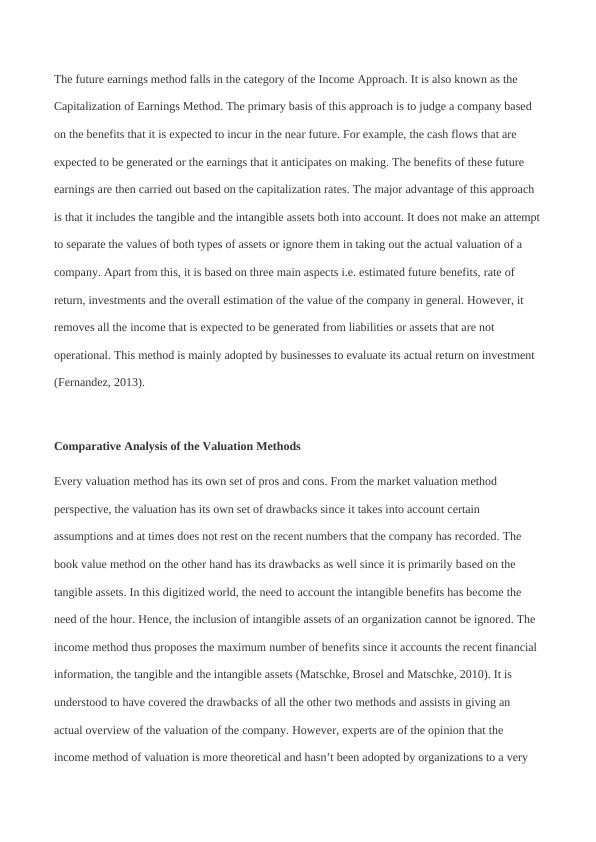Market Capitalization and Human Resource Management
Added on 2023-03-23
7 Pages1834 Words99 Views
Market Capitalization and Human Resource Management
Author’s Name
Institutional Affiliation
Date
Author’s Name
Institutional Affiliation
Date

Parts 1 and 2:
Market Capitalization Method:
Market Capitalization can be defined as the valuation of a company as measured by the stock price
times as compared to the number of shares issued. To exemplify, if an organization is selling 1000
shares at a price of $5 each then the market capitalisation of that organization would be accounted as
$5000. Some of the strengths include user friendly, it is based on actual data, it is simply applicable
and does not rely on any type of forecasts. The limitations include inability to compare recent data
about the company and judge the proper evaluation, standards of forming a value are not clear
enough, the assumptions made are not revealed majority of the times, it is a very costly way of
analysing the value of the company, it is not a flexible approach like its other counterparts and
reliability on the valuation is low as well (Twain, 2012).
The Book Value Method:
The book value method is among the many approaches that fall in the category of the Asset based
approach wherein the assets of an organization are taken into consideration for evaluation of the
company. The book value method for valuation is an attempt to determine the equity of an
organization that is primarily based on the financial accounting. It subtracts the liabilities on a
company from the book value of the assets to determine the actual value of an organization. It is
widely used approach but is often rejected due to some serious number of limitations to it. For
example, the recognition to intangible assets such as trademarks, patents and logos is not given, the
long-term liabilities are not recorded as per the market changes, depreciation of the assets is not
subtracted from the current value of them and the rates of market change are not applied. Hence, a
valid measure of the valuation of the company is not adequately done under the book value method
(Reilly, 2015).
Future Earnings Method:
Market Capitalization Method:
Market Capitalization can be defined as the valuation of a company as measured by the stock price
times as compared to the number of shares issued. To exemplify, if an organization is selling 1000
shares at a price of $5 each then the market capitalisation of that organization would be accounted as
$5000. Some of the strengths include user friendly, it is based on actual data, it is simply applicable
and does not rely on any type of forecasts. The limitations include inability to compare recent data
about the company and judge the proper evaluation, standards of forming a value are not clear
enough, the assumptions made are not revealed majority of the times, it is a very costly way of
analysing the value of the company, it is not a flexible approach like its other counterparts and
reliability on the valuation is low as well (Twain, 2012).
The Book Value Method:
The book value method is among the many approaches that fall in the category of the Asset based
approach wherein the assets of an organization are taken into consideration for evaluation of the
company. The book value method for valuation is an attempt to determine the equity of an
organization that is primarily based on the financial accounting. It subtracts the liabilities on a
company from the book value of the assets to determine the actual value of an organization. It is
widely used approach but is often rejected due to some serious number of limitations to it. For
example, the recognition to intangible assets such as trademarks, patents and logos is not given, the
long-term liabilities are not recorded as per the market changes, depreciation of the assets is not
subtracted from the current value of them and the rates of market change are not applied. Hence, a
valid measure of the valuation of the company is not adequately done under the book value method
(Reilly, 2015).
Future Earnings Method:

The future earnings method falls in the category of the Income Approach. It is also known as the
Capitalization of Earnings Method. The primary basis of this approach is to judge a company based
on the benefits that it is expected to incur in the near future. For example, the cash flows that are
expected to be generated or the earnings that it anticipates on making. The benefits of these future
earnings are then carried out based on the capitalization rates. The major advantage of this approach
is that it includes the tangible and the intangible assets both into account. It does not make an attempt
to separate the values of both types of assets or ignore them in taking out the actual valuation of a
company. Apart from this, it is based on three main aspects i.e. estimated future benefits, rate of
return, investments and the overall estimation of the value of the company in general. However, it
removes all the income that is expected to be generated from liabilities or assets that are not
operational. This method is mainly adopted by businesses to evaluate its actual return on investment
(Fernandez, 2013).
Comparative Analysis of the Valuation Methods
Every valuation method has its own set of pros and cons. From the market valuation method
perspective, the valuation has its own set of drawbacks since it takes into account certain
assumptions and at times does not rest on the recent numbers that the company has recorded. The
book value method on the other hand has its drawbacks as well since it is primarily based on the
tangible assets. In this digitized world, the need to account the intangible benefits has become the
need of the hour. Hence, the inclusion of intangible assets of an organization cannot be ignored. The
income method thus proposes the maximum number of benefits since it accounts the recent financial
information, the tangible and the intangible assets (Matschke, Brosel and Matschke, 2010). It is
understood to have covered the drawbacks of all the other two methods and assists in giving an
actual overview of the valuation of the company. However, experts are of the opinion that the
income method of valuation is more theoretical and hasn’t been adopted by organizations to a very
Capitalization of Earnings Method. The primary basis of this approach is to judge a company based
on the benefits that it is expected to incur in the near future. For example, the cash flows that are
expected to be generated or the earnings that it anticipates on making. The benefits of these future
earnings are then carried out based on the capitalization rates. The major advantage of this approach
is that it includes the tangible and the intangible assets both into account. It does not make an attempt
to separate the values of both types of assets or ignore them in taking out the actual valuation of a
company. Apart from this, it is based on three main aspects i.e. estimated future benefits, rate of
return, investments and the overall estimation of the value of the company in general. However, it
removes all the income that is expected to be generated from liabilities or assets that are not
operational. This method is mainly adopted by businesses to evaluate its actual return on investment
(Fernandez, 2013).
Comparative Analysis of the Valuation Methods
Every valuation method has its own set of pros and cons. From the market valuation method
perspective, the valuation has its own set of drawbacks since it takes into account certain
assumptions and at times does not rest on the recent numbers that the company has recorded. The
book value method on the other hand has its drawbacks as well since it is primarily based on the
tangible assets. In this digitized world, the need to account the intangible benefits has become the
need of the hour. Hence, the inclusion of intangible assets of an organization cannot be ignored. The
income method thus proposes the maximum number of benefits since it accounts the recent financial
information, the tangible and the intangible assets (Matschke, Brosel and Matschke, 2010). It is
understood to have covered the drawbacks of all the other two methods and assists in giving an
actual overview of the valuation of the company. However, experts are of the opinion that the
income method of valuation is more theoretical and hasn’t been adopted by organizations to a very

End of preview
Want to access all the pages? Upload your documents or become a member.
Related Documents
Role of Mark to Market Accounting Approach in Enron’s falllg...
|10
|2630
|138
Evolution of Value Relevance in Accounting for New Economylg...
|4
|551
|192
Evaluating Performance and Appraising Limitationslg...
|32
|5887
|102
Fair Value Accounting | Corporate Accountinglg...
|10
|2064
|18
THE FINANCE AND INVESTMENTlg...
|11
|2864
|18
Understanding the Concept of Implementation of Accounting Standardslg...
|8
|2180
|287
